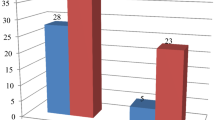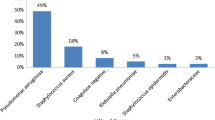Abstract
Background
Chronic suppurative otitis media takes a lot of time in the hospital outdoors and a considerable amount of O.T. timings. Chronic suppurative otitis media may be either active chronic otitis media or a sequel of previous otitis media.
Objective
(a) To understand the bacteriology of Chronic suppurative otitis media (b) Their susceptibility patterns to commonly used antibiotics in this age of emerging resistance (c) the seasonal variation in the bacteriological pattern (d) For better empirical treatment of C.S.O.M where culture facilities are not available so that both intracranial and extra cranial complications can be avoided.
Materials and Methods
The secretions of 160 samples belonging to various age groups and of both sexes of clinically proven chronic suppurative otitis media with definitive exclusion and inclusion criteria were collected and cultured by aerobic and anaerobic methods. Drug sensitivity was done according to standard laboratory protocols. A month wise visit of the patients has been recorded to note any seasonal variations in the isolates.
Results
The most common aerobic organism is Pseudomonas Spp and most common anaerobes isolated being Bacteriodes species. Their susceptibility patterns and seasonal variations have been discussed.
Conclusions
It is observed that chronic suppurative otitis media affects mainly younger group of population, mostly (86.8%) below 40 years of age. Majority of them (31.9%) belonged to, 10–19 years of age. The most common isolate being Pseudomonas Spp. (64.4%) followed by Staphylococcus aureus (33.8%). In the anaerobic group (1.8%) the Bacteriodes species is most prevalent. The most effective antibiotic in the aerobic isolates is Amikacin followed by Gentamicin and Cefotaxime where as for anaerobic isolates Cefoperazone sodium has better sensitivity. The isolation rates of both aerobic and anaerobic groups of organisms are more in the month of July to September, which is the monsoon season in this place. Isolation of Pseudomonas Spp. in Monsoon and post monsoon season may have been due to filling up of water bodies with rain water and infection with an omnipresent saprophytic organism like Pseudomonas Spp.
Similar content being viewed by others
References
Attaullah MSW. Microbiology of Chronic suppurative otitis media with cholesteatoma, Saudi Med J 2000: 21: 924–7.
Altuntas A, Aslon A, Eren N, et al. Susceptibility of microorganisms isolated from chronic suppurative otitis media to ciprofloxacin. Eur arch otolayngol 1996:53:364–366.
Bluestone CD. Efficacy of ofloxacin and other ototopical preparations for chronic suppurative otitis media in children Pediatr infect. Dis J 2001:20:111–5
Bodey GP et al: Infections caused by Pseudomonas aeruginosa, Rev infect Dis 1983:5:279.
Dohar JE, Kenna MA, Wadowsky RM in vitro susceptibility of aural isolates of Pseudomonas aeruginosa to commonly used ototopical antibiotics. Am J otol 1996:17: 207–9.
Fass RJ et al: in Vitro activities of Quinolones,Beta lactams,Tobramycin and Trimethoprin Sulphamethoxazole against nonfermentative Gram negative bacteria. Antimicrob agents Chemother 1996:40:1412.
Hannley MT, Denney JC III, Holzer SS, Use of Ototopical antibiotics in treating 3 common ear diseases, Otolaryngol Head Neck Surg: 2000 122: 934–40.
Miro. N. Controlled multicenter study on chronic suppurative otitis Media treated with topical applications of Ciprofloxacin 0.2% soln in single dose containers or combination of PolymyxinB, Neomycin and Hydrocortisone suspension Otolaryngol Head Neck Surg 2000: 123:617–623.
Vartiainen E, Vartiainen J, Effect of aerobic bacteriology on the clinical presentation and treatment results in chronic suppurative otitis media, J Laryngol otol 1996:110:315–318
Woods DE Iglewski BH: toxins of Pseudomona aeruginosa: New perspective. Rev infects Dis. 1983: 56(supp4):S715.
Brook I, Van de Heyning PH, 1994, Microbiology and management of otitis media, Scand J infect dis suppl, 93:20–32.
Author information
Authors and Affiliations
Corresponding author
Rights and permissions
About this article
Cite this article
Maji, P.K., Chatterjee, T.K., Chatterjee, S. et al. The investigation of bacteriology of chronic suppurative otitis media in patients attending a tertiary care hospital with special emphasis on seasonal variation. Indian J Otolaryngol Head Neck S 59, 128–131 (2007). https://doi.org/10.1007/s12070-007-0038-x
Published:
Issue Date:
DOI: https://doi.org/10.1007/s12070-007-0038-x




